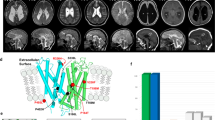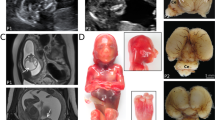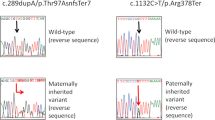Abstract
Microcephaly–capillary malformation (MIC-CAP) syndrome is characterized by severe microcephaly with progressive cortical atrophy, intractable epilepsy, profound developmental delay and multiple small capillary malformations on the skin. We used whole-exome sequencing of five patients with MIC-CAP syndrome and identified recessive mutations in STAMBP, a gene encoding the deubiquitinating (DUB) isopeptidase STAMBP (STAM-binding protein, also known as AMSH, associated molecule with the SH3 domain of STAM) that has a key role in cell surface receptor–mediated endocytosis and sorting. Patient cell lines showed reduced STAMBP expression associated with accumulation of ubiquitin-conjugated protein aggregates, elevated apoptosis and insensitive activation of the RAS-MAPK and PI3K-AKT-mTOR pathways. The latter cellular phenotype is notable considering the established connection between these pathways and their association with vascular and capillary malformations. Furthermore, our findings of a congenital human disorder caused by a defective DUB protein that functions in endocytosis implicates ubiquitin-conjugate aggregation and elevated apoptosis as factors potentially influencing the progressive neuronal loss underlying MIC-CAP syndrome.
This is a preview of subscription content, access via your institution
Access options
Subscribe to this journal
Receive 12 print issues and online access
$209.00 per year
only $17.42 per issue
Buy this article
- Purchase on Springer Link
- Instant access to full article PDF
Prices may be subject to local taxes which are calculated during checkout





Similar content being viewed by others
Accession codes
References
Carter, M.T. et al. A new syndrome with multiple capillary malformations, intractable seizures, and brain and limb anomalies. Am. J. Med. Genet. A. 155A, 301–306 (2011).
Isidor, B., Barbarot, S., Bénéteau, C., Le Caignec, C. & David, A. Multiple capillary skin malformations, epilepsy, microcephaly, mental retardation, hypoplasia of the distal phalanges: report of a new case and further delineation of a new syndrome. Am. J. Med. Genet. A. 155A, 1458–1460 (2011).
Mirzaa, G.M. et al. The microcephaly-capillary malformation syndrome. Am. J. Med. Genet. A. 155A, 2080–2087 (2011).
Carter, M.T. & Boycot, K.M. Microcephaly-capillary malformation syndrome: a story of rapid emergence of a new recognizable entity. Am. J. Med. Genet. A. 155A, 2078–2079 (2011).
Jacobs, A.H. & Walton, R.G. The incidence of birthmarks in the neonate. Pediatrics 58, 218–222 (1976).
Eerola, I. et al. Capillary malformation-arteriovenous malformation, a new clinical and genetic disorder caused by RASA1 mutations. Am. J. Hum. Genet. 73, 1240–1249 (2003).
Eerola, I. et al. KRIT1 is mutated in hyperkeratotic cutaneous capillary-venous malformation associated with cerebral capillary malformation. Hum. Mol. Genet. 9, 1351–1355 (2000).
Barash, Y. et al. Deciphering the splicing code. Nature 465, 53–59 (2010).
Sierra, M.I., Wright, M.H. & Nash, P.D. AMSH interacts with ESCRT-0 to regulate the stability and trafficking of CXCR4. J. Biol. Chem. 285, 13990–14004 (2010).
Tsang, H.T.H. et al. A systematic analysis of human CHMP protein interactions: additional MIT domain-containing proteins bind to multiple components of the human ESCRT III complex. Genomics 88, 333–346 (2006).
Tanaka, N. et al. Possible involvement of a novel STAM-associated molecule 'AMSH' in intracellular signal transduction mediated by cytokines. J. Biol. Chem. 274, 19129–19135 (1999).
McCullough, J. et al. Activation of the endosome-associated ubiquitin isopeptidase AMSH by STAM, a component of the multivesicular body-sorting machinery. Curr. Biol. 16, 160–165 (2006).
Agromayor, M. & Martin-Serrano, J. Interaction of AMSH with ESCRT-III and deubiquitination of endosomal cargo. J. Biol. Chem. 281, 23083–23091 (2006).
Mizuno, E., Kobayashi, K., Yamamoto, A., Kitamura, N. & Komada, M. A deubiquitinating enzyme UBPY regulates the level of protein ubiquitination on endosomes. Traffic 7, 1017–1031 (2006).
Kim, M.S., Kim, J.A., Song, H.K. & Jeon, H. STAM-AMSH interaction facilitates the deubiquitination activity in the C-terminal AMSH. Biochem. Biophys. Res. Commun. 351, 612–618 (2006).
Kyuuma, M. et al. AMSH, an ESCRT-III associated enzyme, deubiquitinates cargo on MVB/late endosomes. Cell Struct. Funct. 31, 159–172 (2007).
Raiborg, C. & Stenmark, H. The ESCRT machinery in endosomal sorting of ubiquitylated membrane proteins. Nature 458, 445–452 (2009).
Komada, M. Controlling receptor downregulation by ubiquitination and deubiquitination. Curr. Drug Discov. Technol. 5, 78–84 (2008).
Wright, M.H., Berlin, I. & Nash, P.D. Regulation of endocytic sorting by ESCRT-DUB–mediated deubiquitination. Cell Biochem. Biophys. 60, 39–46 (2011).
Suzuki, S. et al. AMSH is required to degrade ubiquitinated proteins in the central nervous system. Biochem. Biophys. Res. Commun. 408, 582–588 (2011).
Williams, R.L. & Urbé, S. The emerging shape of the ESCRT machinery. Nat. Rev. Mol. Cell Biol. 8, 355–368 (2007).
Sowa, M.E., Bennett, E.J., Gygi, S.P. & Harper, J.W. Defining the human deubiquitinating enzyme interaction landscape. Cell 138, 389–403 (2009).
Boon, L.M., Mulliken, J.B. & Vikkula, M. RASA1: variable phenotype with capillary and arteriovenous malformations. Curr. Opin. Genet. Dev. 15, 265–269 (2005).
Tidyman, W.E. & Rauen, K.A. The RASopathies: developmental syndromes of Ras/MAPK pathway dysregulation. Curr. Opin. Genet. Dev. 19, 230–236 (2009).
Ishii, N. et al. Loss of neurons in the hippocampus and cerebral cortex of AMSH-deficient mice. Mol. Cell Biol. 21, 8626–8637 (2001).
Kato, M., Miyazawa, K. & Kitamura, N. A deubiquitinating enzyme UBPY interacts with the Src homology 3 domain of Hrs-binding protein via a novel binding motif PX(V/I)(D/N)RXXKP. J. Biol. Chem. 275, 37481–37487 (2000).
Davies, C.W., Paul, L.N., Kim, M.I. & Das, C. Structural and thermodynamic comparison of the catalytic domain of AMSH and AMSH-LP: nearly identical fold but different stability. J. Mol. Biol. 413, 416–429 (2011).
Ma, Y.M. et al. Targeting of AMSH to endosomes is required for epidermal growth factor receptor degradation. J. Biol. Chem. 282, 9805–9812 (2007).
Li, H. & Durbin, R. Fast and accurate long-read alignment with Burrows-Wheeler transform. Bioinformatics 26, 589–595 (2010).
Li, H. et al. The Sequence Alignment/Map format and SAMtools. Bioinformatics 25, 2078–2079 (2009).
Wang, K., Li, M. & Hakonarson, H. ANNOVAR: functional annotation of genetic variants from high-throughput sequencing data. Nucleic Acids Res. 38, e164 (2010).
Acknowledgements
The authors would like to thank the study patients and their families, without whose participation this work would not be possible. This work was funded by the Government of Canada through Genome Canada, the Canadian Institutes of Health Research (CIHR) and the Ontario Genomics Institute (OGI-049) (to K.M.B.). Additional funding was provided by Genome Quebec and Genome British Columbia (to K.M.B.), the US National Institutes of Health under National Institute of Neurological Disorders and Stroke (NINDS) grant NS058721 (to W.B.D.), as well as National Institute of Child Health and Human Development (NICHD) grant HD36657 and National Institute of General Medicine Sciences (NIGMS) grant 5-T32-GM08243 (to J.M.G.) and the Leukaemia Lymphoma Research (UK), Medical Research Council (UK) and Cancer Research UK (CR-UK) (to M.O.). The authors acknowledge the contribution of the high-throughput sequencing platform of the McGill University and Génome Québec Innovation Centre, Montréal, Canada, as well as M. Moellers, (Pediatric Radiology, Evangelisches Krankenhaus Bielefeld). This work was selected for study by the FORGE Canada Steering Committee, consisting of K. Boycott (University of Ottawa), J. Friedman (University of British Columbia), J. Michaud (University of Montreal), F. Bernier (University of Calgary), M. Brudno (University of Toronto), B. Fernandez (Memorial University), B. Knoppers (McGill University), M. Samuels (University of Montreal) and S. Scherer (University of Toronto). L.M.M. is supported by a Frederick Banting Graduate Scholarship from CIHR. M.O. is a CR-UK Senior Cancer Research Fellow. K.M.B. is supported by a Clinical Investigatorship Award from the CIHR Institute of Genetics.
Author information
Authors and Affiliations
Consortia
Contributions
K.M.B., M.O., W.B.D. and D.E.B. directed the study. M.T.C., L.J.L., C.L.C., J.M.G., D.J.M.-R., T.P., G.A., S.T., S.W., A.H., B.I., A.D., C.D.S., A.R.P., M.W., J.W., S.D., M.T.G., G.M.M., W.B.D. and K.M.B. provided clinical data. L.M.M. performed Sanger sequencing, genotyping studies and variant analysis supervised by K.M.B. and D.E.B. D.A. performed the protein biochemistry and cell biology studies, which were directed by M.O. J.S. and J. Majewski performed exome variant calling analysis. The manuscript was written by L.M.M., G.M.M., M.O. and K.M.B. FORGE Canada Consortium provided the clinical and bioinformatic infrastructure under the direction of K.M.B. assisted by C.L.B. and J. Marcadier. All authors reviewed the manuscript.
Corresponding authors
Ethics declarations
Competing interests
The authors declare no competing financial interests.
Additional information
Membership of the Steering Committee for the Consortium is provided in the Acknowledgments section.
Supplementary information
Supplementary Text and Figures
Supplementary Figures 1–6 and Supplementary Tables 1–3 (PDF 854 kb)
Rights and permissions
About this article
Cite this article
McDonell, L., Mirzaa, G., Alcantara, D. et al. Mutations in STAMBP, encoding a deubiquitinating enzyme, cause microcephaly–capillary malformation syndrome. Nat Genet 45, 556–562 (2013). https://doi.org/10.1038/ng.2602
Received:
Accepted:
Published:
Issue Date:
DOI: https://doi.org/10.1038/ng.2602
This article is cited by
-
The expression and clinical significance of STAMBP in breast cancer
Molecular Biology Reports (2023)
-
The deubiquitinating enzyme STAMBP is a newly discovered driver of triple-negative breast cancer progression that maintains RAI14 protein stability
Experimental & Molecular Medicine (2022)
-
Comprehensive targeted next-generation sequencing in patients with slow-flow vascular malformations
Journal of Human Genetics (2022)
-
Deubiquitylases in developmental ubiquitin signaling and congenital diseases
Cell Death & Differentiation (2021)
-
Application of Next-Generation Sequencing in Neurodegenerative Diseases: Opportunities and Challenges
NeuroMolecular Medicine (2021)



